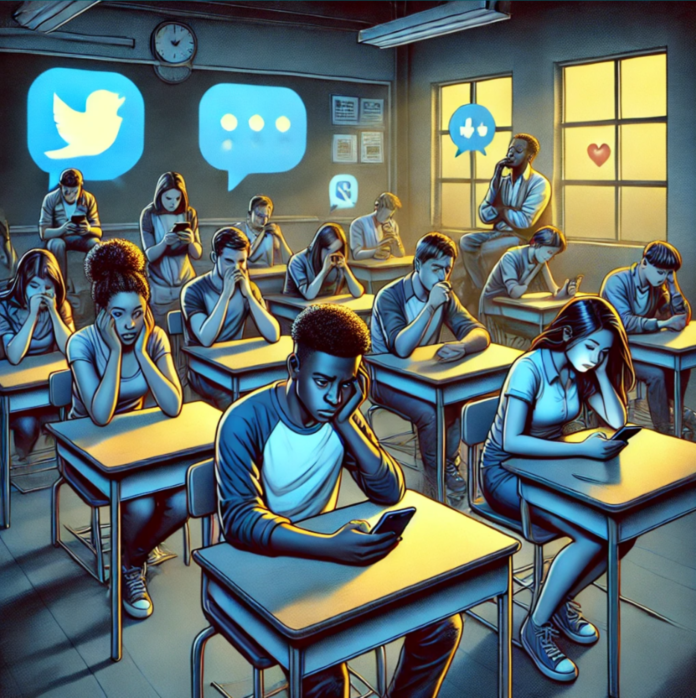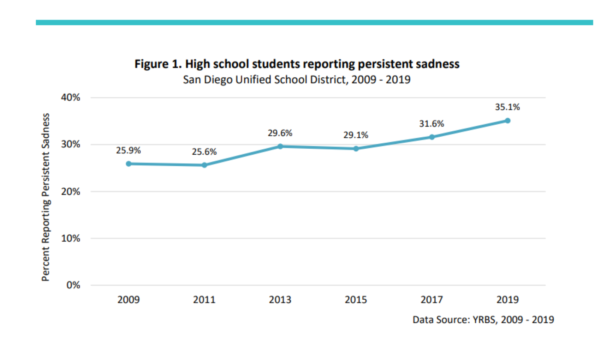
By Macy Meinhardt, Voice & Viewpoint Staff Writer
Among a series of contested efforts to counteract the youth mental health crisis, the San Diego County Board of Supervisors voted 4-1 during their Aug. 27 meeting in favor of a proposal to limit student access to their cell phones during the school day.
In recent years, school districts and governing boards across the country have been fighting to curb growing mental health concerns among students–an issue District 3 Supervisor TerraLawson Remer argues is linked to smartphone and social media usage.
“The rates of depression and anxiety and suicidal ideation have more than doubled among teenagers Since 2011 and that it’s very clearly tied to the rise in smartphone usage,” said Supervisor Lawson-Remer.
Inside the life of a young person’s smartphone use, students on average receive 237 notifications throughout the school day, a Common Sense report finds. Constant access to messages, social media, and games fosters a pervasive environment of distraction, social pressure, and potential cyberbullying, the county’s proposal reads. Subsequently creating barriers to positive mental health and learning.
In response, the policy directs the County of San Diego to collaborate with the San Diego County Office of Education to develop a range of options, like lockable phone pouches, for administrators and teachers to combat cell phone distractions.
County leaders unanimously supported the need for extra resources to bolster schools’ efforts on student wellness— but are phones in school truly to blame for poor mental health trends? Supervisor Chair Nora Vargas says she is not so sure, while Supervisors Joel Anderson and Jim Desmond question the approach.
“I don’t think smart phones are necessarily the reason for the youth mental health crisis,” Vargas said. “Taking away a smart phone is not going to make healthier young people.”
The stats on youth healthcare are reported as grim. Data from the Department of Health and Human Services shows that from 2016 to 2020, anxiety and depression in minors shot up by 70%. Meanwhile, it is reported that at local hospital Rady Childrens, Benjamin Maxwell, MD, division chief of child and adolescent psychiatry and chair in behavioral health, told Chief Healthcare Executive® in December 2022 that the uptick in pediatric mental health emergencies “is beyond unprecedented for us.” This is followed by a 30% increase in behavioral health emergency room visits Rady reported almost a year later, in Oct. 2023.

Data from the Center of Disease Control shows that the suicide rate among Black youth ages 10 to 19 surpassed that of their White peers for the first time in 2022, increasing 54% since 2018, compared to a 17% decrease for White youth.
While the county is empowered to act on the behalf of the region’s health and safety, the punitive nature of banning technology that is one, already deeply integrated in students’ lives, and two, is used as a learning tool and safety resource for students was another concern brought up.
Caitlin Radigan, who is both a parent, and a student at San Diego State University says the proposal to ban phones is formulated from a “place of fear, rather than understanding.”
“Instead of resisting the reality that our children are drawn to phones, we should harness this opportunity for engagement, for educational services, and we should challenge our educators to incorporate these tools in their lesson plans and encourage students to create educational content on social media,” said Radigan.
Meanwhile, other residents at the meeting say that banning phones is an unnecessary government inference in schools.
“Parents don’t need this county government to inflict its presence in the mire that is the local school districts,” said Pam, an attendee during public comment.
Supervisor Lawson-Remer denies that the policy is an outright ban and instead says,
“The intention and spirit of this is to acknowledge that there’s a holistic set of issues and challenges facing our young people, and it’s not about banning smartphones. What it’s about is working with our schools and being a better partner as our school districts kind of try to come up with policies,” says Lawson-Remer.
Along with developing a collaborative phone policy plan for districts, the proposal also builds on a pilot program Lawson-Remer launched in district 3 with non-profit Campana Studio.
The non-profit partnership comes from a $100,000 grant Campana Studio’s received by the county to provide lockable mobile phone pouches, cell phone lockers, or mobile phone pocket holders for middle and highschools in District 3 interested in participating.
The proposal also comes after California Gov. Gavin Newsom sent a letter to California schools in August urging them to implement tighter cell phone policies.
“The urgency of this issue is underscored by a growing movement among policymakers and educational leaders to limit or ban smartphone usage in schools to mitigate the detrimental effects of unregulated smartphone use on students’ mental health and academic performance,” the proposal states.
Cell phone restrictions in California schools also stems from an assembly bill Gov. Newsom signed over four years ago, AB 272, which granted school districts the authority to regulate the use of smartphones during school hours.
While District 5 Supervisor Anderson agreed to support schools on mental health, when it comes to the reach of banning phones, he states his intentions to “tread lightly” and allow the schools to take the lead.
Meanwhile, Supervisor for District 2, Joel Anderson, voted no altogether, saying that it is not his role as supervisor to manage phone usage.
“I got elected to the board of sups, not to the school board,” said Anderson.
“I’m going to trust that my school board and our Attorney General can handle this issue. So I’ll be a no vote, not because I don’t have an opinion. I just don’t want to get out of my lane. I’m going to let the school districts stay in their lane, and I’ll stay in mine.”



